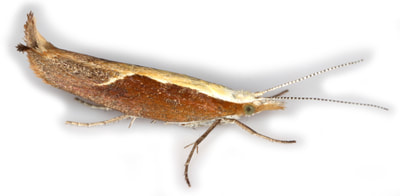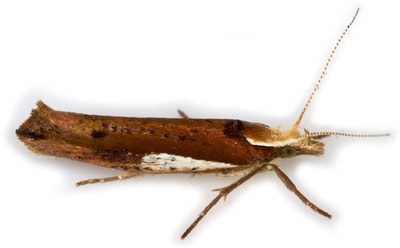Suborder:Glossata Infraorder:Heteroneura, Superfamily:Yponomeutoidea
In MBGBI3 subfamily: Ypsolophinae is treated as a subfamily of family: Yponomeutidae and
subfamily: Ochsenheimeriinae is treated as family: Ochsenheimeriidae
Ref: MBGBI2&3
Other than that S2 of labial palp is tufted in both, I do not know what features unite the 2 subfamilies and exclude all other families.
In MBGBI3 subfamily: Ypsolophinae is treated as a subfamily of family: Yponomeutidae and
subfamily: Ochsenheimeriinae is treated as family: Ochsenheimeriidae
Ref: MBGBI2&3
Other than that S2 of labial palp is tufted in both, I do not know what features unite the 2 subfamilies and exclude all other families.
Subfamily: Ypsolophinae (1G 13S -1EX) Key to Ypsolopha
Genus Ypsolopha
Labial palp S2 tufted
Hindtibia smooth-scaled
Lateral pleura of abdominal S8 expanded posteriorly; Abdominal tergites not spined
V7 of forewing to termen
Hindwing V6&7 separate (this being the main feature separating Ypsolophinae from Plutellinae according to the key to subfamilies of Yponomeutidae as presented in MBGBI3p42; however in the introduction to Ypsolophinae on p89 it states "veins 7&6 of the hindwing are stalked or coincident" and in the introduction to plutellinae on p98 it states veins 6&5 (of hindwing) stalked. I am confused!)
Male genitalia: aedeagus with 2 cornuti or 2 groups of cornuti
Female genitalia: anterior and posterior apophyses long; ductus seminilis joins ductus bursae near ostium; signum an elongate plate with 2 transverse ridges
Labial palp S2 tufted
Hindtibia smooth-scaled
Lateral pleura of abdominal S8 expanded posteriorly; Abdominal tergites not spined
V7 of forewing to termen
Hindwing V6&7 separate (this being the main feature separating Ypsolophinae from Plutellinae according to the key to subfamilies of Yponomeutidae as presented in MBGBI3p42; however in the introduction to Ypsolophinae on p89 it states "veins 7&6 of the hindwing are stalked or coincident" and in the introduction to plutellinae on p98 it states veins 6&5 (of hindwing) stalked. I am confused!)
Male genitalia: aedeagus with 2 cornuti or 2 groups of cornuti
Female genitalia: anterior and posterior apophyses long; ductus seminilis joins ductus bursae near ostium; signum an elongate plate with 2 transverse ridges
Subfamily: Ochsenheimeriinae (1G 3S)
Genus: Ochsenheimeria
Vertex with long, shaggy hair-scales, frons smooth-scaled but usually covered by long scales drooping from vertex
Antenna slightly >1/2 forewing length; scape elongate and variably clad in long hair-scales; held extended and weakly sinuate (bull's horns)
Ocelli present; Proboscis developed; Maxillary palps short, 2-segmented
Labial palps moderate, porrect; S2 with dense brush of broad hair scales which almost conceals the short S3
Forewing subrectangular; Hindwing elongate-ovate; cilia slightly shorter than width of wing; V6&7 either forked near apex or completely fused
Foretibia without epiphysis
Vertex with long, shaggy hair-scales, frons smooth-scaled but usually covered by long scales drooping from vertex
Antenna slightly >1/2 forewing length; scape elongate and variably clad in long hair-scales; held extended and weakly sinuate (bull's horns)
Ocelli present; Proboscis developed; Maxillary palps short, 2-segmented
Labial palps moderate, porrect; S2 with dense brush of broad hair scales which almost conceals the short S3
Forewing subrectangular; Hindwing elongate-ovate; cilia slightly shorter than width of wing; V6&7 either forked near apex or completely fused
Foretibia without epiphysis
|
014 Ochsenheimeria taurella
(Hairy Stem Moth) |
015 Ochsenheimeria urella
(Bull's-horn Stem Moth) ws: 9-12mm; Jul-Sep diurnal flies in morning sunshine; various grasses; local in grassland throughout GB |
016 Ochsenheimeria vacculella
(Cereal Stem Moth) ws: 11-12mm; Jul-Aug diurnal flies briefly at midday; varoius grasses; NS-A - in grassland and arable country in England, rests for much of the day under loose bark. |












